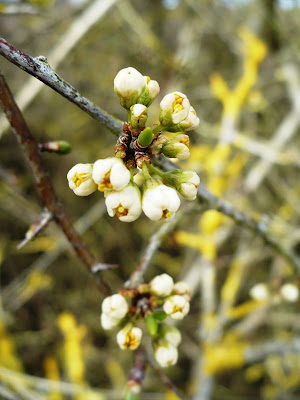
Blackthorn (Prunus spinosa) was in flower in Swansea in time for my leaving for the Himalayas.
This blog may help people explore some of the 'hidden' issues involved in certain media treatments of environmental and scientific issues. Using personal digital images, it's also intended to emphasise seasonal (and other) changes in natural history of the Swansea (South Wales) area. The material should help participants in field-based modules and people generally interested in the natural world. The views are wholly those of the author.








 In Penclacwydd, saw male and female flowers of Alder (Alnus glutinosa) and the Blackthorn (Prunus spinosa) was about to bloom. Hawthorn (Crataegus monogyna), Hazel (Corylus avellana) and Bramble (Rubus fruticosus) were all coming into leaf there. In Loughor, Dandelion (Taraxacum sp), Heather (Calluna vulgaris) and Common dog violet (Viola rivinia) were all in flower. Also saw the first wild butterfly of the year, a Comma (Polygonia c-album) from hibernation. The beastie played dead for some time.
In Penclacwydd, saw male and female flowers of Alder (Alnus glutinosa) and the Blackthorn (Prunus spinosa) was about to bloom. Hawthorn (Crataegus monogyna), Hazel (Corylus avellana) and Bramble (Rubus fruticosus) were all coming into leaf there. In Loughor, Dandelion (Taraxacum sp), Heather (Calluna vulgaris) and Common dog violet (Viola rivinia) were all in flower. Also saw the first wild butterfly of the year, a Comma (Polygonia c-album) from hibernation. The beastie played dead for some time.+with+bars+Bynea.jpg)
+fawn.jpg) It seems that the UK's deer population are generally in a rude state of health -with more said to be in the country than at any time in the last one thousand years (http://www.wildlifeextra.com/go/news/uk-deer009.html#cr). That, the greater connectivity between green spaces and the fact that culling is difficult to impossible in urban areas has reportedly led to many more deer taking up residence in towns and cities (being somewhat territorial, the less successful animals are forced out of so-called wild locations). This is presumably most obvious in the case of smaller alien species such as the Sika and Muntjac. Many city dwellers might well like to catch view of the occasional deer but there can be problems associated with these animals. They can decimate plants in gardens and parks (young trees can effectively be trashed), they can be involved in accidents with motor vehicles and they sometimes serve as reservoir hosts of tick-borne Lyme's disease. Deer can also be distinctly unpleasant when competing in the rutting season. As most deer are not legally owned by anyone, getting compensation for deer-associated damage can be difficult.
It seems that the UK's deer population are generally in a rude state of health -with more said to be in the country than at any time in the last one thousand years (http://www.wildlifeextra.com/go/news/uk-deer009.html#cr). That, the greater connectivity between green spaces and the fact that culling is difficult to impossible in urban areas has reportedly led to many more deer taking up residence in towns and cities (being somewhat territorial, the less successful animals are forced out of so-called wild locations). This is presumably most obvious in the case of smaller alien species such as the Sika and Muntjac. Many city dwellers might well like to catch view of the occasional deer but there can be problems associated with these animals. They can decimate plants in gardens and parks (young trees can effectively be trashed), they can be involved in accidents with motor vehicles and they sometimes serve as reservoir hosts of tick-borne Lyme's disease. Deer can also be distinctly unpleasant when competing in the rutting season. As most deer are not legally owned by anyone, getting compensation for deer-associated damage can be difficult.
+near+a+pond.jpg) There is an initiative to co opt the general public into recording a range of alien species in the UK countryside (http://www.guardian.co.uk/environment/2010/mar/22/bioblitz-campaign-record-britain-wildlife). The six species that are the focus are American skunk cabbage (Lysichiton americanus); Chinese mitten crab (Eriocheir sinensis); Muntjac deer (Muntiacus reevesi); Tree of heaven (Ailanthus altissima); Water primrose (Ludwigia peploides) and the Zebra mussel (Dreissena polymorpha). Some cause actual problems whereas others are mainly characterised by a bad smell. The idea is that the amateurs would report the occurrences and experts would check the claims before mapping the items. The proposal seems useful on both a surveying level and in enthusing a new generation about the world around them. One wonders why the initial focus is on these six.
There is an initiative to co opt the general public into recording a range of alien species in the UK countryside (http://www.guardian.co.uk/environment/2010/mar/22/bioblitz-campaign-record-britain-wildlife). The six species that are the focus are American skunk cabbage (Lysichiton americanus); Chinese mitten crab (Eriocheir sinensis); Muntjac deer (Muntiacus reevesi); Tree of heaven (Ailanthus altissima); Water primrose (Ludwigia peploides) and the Zebra mussel (Dreissena polymorpha). Some cause actual problems whereas others are mainly characterised by a bad smell. The idea is that the amateurs would report the occurrences and experts would check the claims before mapping the items. The proposal seems useful on both a surveying level and in enthusing a new generation about the world around them. One wonders why the initial focus is on these six.


 The first female flower of the Hazel (Corylus avellana) and Forsythia were out in Penclacwydd. There was also evidence of the current local obsession with grassland fires (http://news.bbc.co.uk/1/hi/wales/8557019.stm). The people who set them often claim they are only attempting to remove undergrowth of gorse and bramble (controlled fire can be helpful in e.g. heathland management to prevent transition to woodland). Fire crews and property-holders often complain about the danger to individuals, agricultural animals and property. What often appears to be forgotten is that the timing of these fires could have a very negative impact on emerging insects, amphibia and reptiles in this location.
The first female flower of the Hazel (Corylus avellana) and Forsythia were out in Penclacwydd. There was also evidence of the current local obsession with grassland fires (http://news.bbc.co.uk/1/hi/wales/8557019.stm). The people who set them often claim they are only attempting to remove undergrowth of gorse and bramble (controlled fire can be helpful in e.g. heathland management to prevent transition to woodland). Fire crews and property-holders often complain about the danger to individuals, agricultural animals and property. What often appears to be forgotten is that the timing of these fires could have a very negative impact on emerging insects, amphibia and reptiles in this location. It has been claimed (http://www.guardian.co.uk/environment/2010/mar/07/extinction-species-evolve) that human impacts are generating a wave of extinctions of species worse than that evident when a collision with a large meteorite seemingly accounted for most of the dinosaurs. The basic problem is said to be that the changes put in train by our species are so fast that animals and plants cannot evolve fast enough to deal with them. Some of the recent 'good news stories' in conservation seem to carry the seeds of their own destruction. For example, a pride of 16 lions in South Africa is threatened with destruction because the owners of their reserve cannot afford the meat to feed them (http://www.guardian.co.uk/world/2010/mar/08/game-reserve-lions-face-death). Mountain gorillas in the Congo are said to receiving new help (http://www.guardian.co.uk/environment/2010/mar/08/mountain-gorillas-drc-congo-virunga) after the impact of war in the region but I am a bit dubious about attempting to reconstitute a complex gorilla society with a juvenile pair of animals.
It has been claimed (http://www.guardian.co.uk/environment/2010/mar/07/extinction-species-evolve) that human impacts are generating a wave of extinctions of species worse than that evident when a collision with a large meteorite seemingly accounted for most of the dinosaurs. The basic problem is said to be that the changes put in train by our species are so fast that animals and plants cannot evolve fast enough to deal with them. Some of the recent 'good news stories' in conservation seem to carry the seeds of their own destruction. For example, a pride of 16 lions in South Africa is threatened with destruction because the owners of their reserve cannot afford the meat to feed them (http://www.guardian.co.uk/world/2010/mar/08/game-reserve-lions-face-death). Mountain gorillas in the Congo are said to receiving new help (http://www.guardian.co.uk/environment/2010/mar/08/mountain-gorillas-drc-congo-virunga) after the impact of war in the region but I am a bit dubious about attempting to reconstitute a complex gorilla society with a juvenile pair of animals.
+shoot+Loughor.jpg) I notice from the news that they have decided not to heed my advice about the potential dangers of attempting to biological control Japanese knotweed by using an alien psyllid insect(http://www.guardian.co.uk/science/2010/mar/09/moth-kill-knotweed). The psyllid is not a moth (it's more closely related to greenfly and scale insects and we know how good they are for plants!). Even more scary is the fact that the sap-sucker (which it is hoped will stick exclusively to knotweed) is being used to introduce a fungal pathogen to the target plants. I appreciate that Japanese knotweed is a very serious alien problem itself, causing lots of damage (especially around the Swansea area) but approximately 50% of attempts at biological control have produced real problems. Horrors include the introduction of the diurnal Mongoose to Hawaii in an attempt to control nocturnal rats in Sugarcane fields leading to the decimation of endemic ground nesting birds. The Cane toad, in turn, was transported to Australia to deal with a damaging beetle in the same crop but ended up killing many unique reptiles and mammals. I appreciate that these are 'old news' and that things are better planned nowadays but I feel that it is very difficult to prevent agents escaping from trial areas. It is also hard to predict precise impacts of these alien agents in the real world. I do hope that my fears are unfounded.
I notice from the news that they have decided not to heed my advice about the potential dangers of attempting to biological control Japanese knotweed by using an alien psyllid insect(http://www.guardian.co.uk/science/2010/mar/09/moth-kill-knotweed). The psyllid is not a moth (it's more closely related to greenfly and scale insects and we know how good they are for plants!). Even more scary is the fact that the sap-sucker (which it is hoped will stick exclusively to knotweed) is being used to introduce a fungal pathogen to the target plants. I appreciate that Japanese knotweed is a very serious alien problem itself, causing lots of damage (especially around the Swansea area) but approximately 50% of attempts at biological control have produced real problems. Horrors include the introduction of the diurnal Mongoose to Hawaii in an attempt to control nocturnal rats in Sugarcane fields leading to the decimation of endemic ground nesting birds. The Cane toad, in turn, was transported to Australia to deal with a damaging beetle in the same crop but ended up killing many unique reptiles and mammals. I appreciate that these are 'old news' and that things are better planned nowadays but I feel that it is very difficult to prevent agents escaping from trial areas. It is also hard to predict precise impacts of these alien agents in the real world. I do hope that my fears are unfounded.

My trip home from Honolulu to Swansea simply cemented how difficult travel has now been made for the elderly (especially if they have a mobi...
